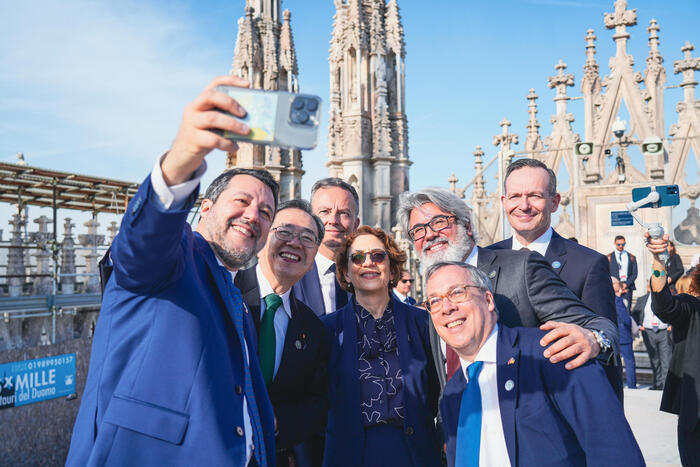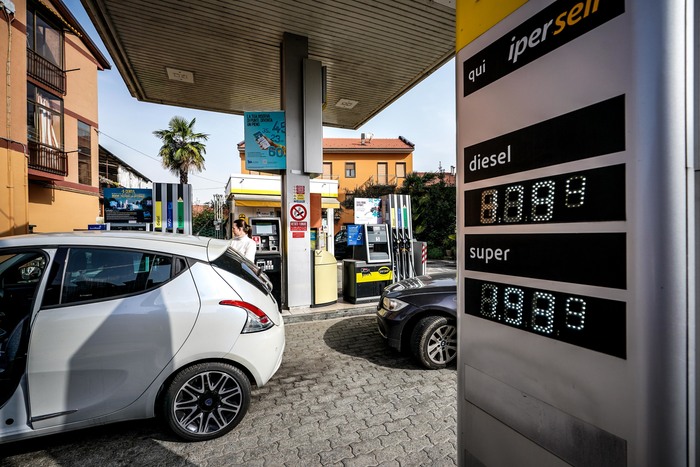Icon: enlarge
Trash can with plastic garbage
Photo: Frank May / picture alliance
It is September 25, 2020, the day of the global climate strike.
While Luisa Neubauer calls out to thousands of demonstrators at the Brandenburg Gate: "Hell yeah, we are still there, we are so from there!" with the sound of his microphone.
A gigafactory - like Tesla
It is windy this Friday in Arnstadt, Thuringia, a good 27,000 inhabitants, on the edge of the largest industrial area in the region, near the Erfurt motorway junction.
Dag, who has slipped into a light blue bespoke suit for the day, doesn't stop him from celebrating: topping-out ceremony, a good 100 guests.
Icon: enlarge
The new papacks production in Arnstadt, Thuringia
Photo: PAPACKS Sales GmbH
37-year-old Dag is the managing director and founder of Papacks, which, according to his own statements, is Europe's “most innovative” producer of molded fiber parts made from renewable raw materials.
Tahsin Dag benefits from the spirit of the times that climate activists such as Fridays for Future have brought into society.
Pharmaceutical company Bayer is just as much a customer of Papacks as the spice manufacturer Fuchs or the perfume and cosmetics manufacturer Coty.
Papacks advertises that its packaging has already replaced more than 2.5 million kilograms of plastic with paper fibers and natural raw materials made from fresh fibers such as industrial hemp and cellulose.
Dag calls the material he extracts from it Greengold, green gold: The Greengold fibers then form the basis for cream jars, drug boxes, coffee capsules, ice cream sundaes, Advent calendars and transport packaging only in environmentally friendly, completely plastic-free.
Fully recyclable.
"Again and again or simply compostable," says Dag.
Icon: enlarge
Tahsin Dag: "With what we do here, we change the world"
Photo: PAPACKS Sales GmbH
This Friday in autumn, Dag, who founded Papacks in 2013 from a garage in the south of Cologne, will open Europe's largest production facility for molded paper fiber parts for more than ten million euros.
Dag calls it Gigafactory.
Just like Tesla, which after several delays plans to open a gigafactory in Grünheide near Berlin in summer 2021;
the first production facility of the US group in Germany.
While the name at Tesla follows a certain logic because of the battery production in gigawatt hours, at Papacks it seems a bit like cocky PR speech.
And yet: 180 million molded paper fiber parts are to be produced here annually from 2021.
On more than 20,000 square meters.
“With what we do here, we change the world.
We're making it a bit more sustainable, ”shouts Dag, who has meanwhile made himself heard so that the last ones at the bar tables will notice.
Plastic levy washes almost six billion into the EU budget
Dag sees itself as a beneficiary of the new plastic levy that will apply to all non-recyclable plastic waste that is used for packaging from January 1st.
When the heads of state and government of the EU states agreed in July on a tax rate of 80 cents per kilogram of non-recyclable plastic, they essentially implemented a proposal that the then EU budget commissioner Günther Oettinger (CDU) had already put forward around two and a half years.
A quarter of the tax, i.e. 20 cents per kilogram, remains in your own country.
The other three quarters, i.e. 60 cents, will be transferred to the EU.
The newly created tax is intended to create an incentive for EU countries to put less dirty plastic into circulation.
The new plastic levy should flush a good 5.7 billion euros into the EU coffers.
The share of the EU budget is calculated to be 1.4 percent for the years 2021 to 2027, which is quite low.
The money is primarily intended to be used for the early repayment of corona aid.
Germany has a big plastic problem
The amount of plastic levy each country has to pay is based on two things: On the one hand, the amount of non-recyclable plastic waste that each EU country causes.
On the other hand, on the level of the gross national income per capita (GNI).
Member States with GNI below the EU average receive a discount.
Stupid for Germany: It is not only the largest European economy, but also the largest European plastics producer and processor, as the "Plastic Atlas" of the Heinrich Böll Foundation for 2019 shows.
In an EU comparison for 2016, only Luxembourg with 50.5 kilograms, Ireland with 46.2 kilograms and Estonia with 42.2 kilograms were even worse than Germany with 38.5 kilograms in terms of per capita consumption of plastic packaging waste.
The Corona period has tightened these numbers.
During the pandemic, Germans produced another six percent more garbage.
more on the subject
Plastic, food, masks: that's how much rubbish a household produces in one weekBy Jan Petter and Gregg Segal (photos)
In figures, this means: Germany contributes around 1.4 billion euros to just under a quarter of the 5.7 billion euros that the new tax flushes into the EU coffers.
Almost 25 percent, which is a bit disproportionate.
In the future, the plastic levy should at least partially replace the German contributions to the EU on the basis of gross national income, as can be seen from the response of the federal government to a small request from the FDP parliamentary group in September.
As with all national contributions to the EU budget, it is up to the federal government to see how the measure is financed.
Do the companies that market the plastic packaging pay the consumers - or the Member States?
A call to Klaus Jacob, Head of Environmental Policy Research at the Free University of Berlin, who has dealt more intensively with the EU plastic tax in recent months.
"The levy is not aimed at manufacturers and consumers of non-recyclable plastic, it is aimed at the member states," says Jacob.
He suspects the new levy has the potential to have an »ecological steering effect«, since member states have an incentive to reduce their consumption of non-recyclable plastic waste.
However, this incentive does not initially arise for those who produce or cause the plastic waste, says Jacob, but only for the member states.
"At the moment," says Jacob, some points are still being "poked into the fog" with the new plastic dispensing.
"A toothless tiger"
Viola Wohlgemuth, who is responsible for the topics of consumption, textiles, plastics and textiles at Greenpeace, criticizes the fact that the levy leaves many questions unanswered: “Now we taxpayers bear the levy for plastic waste.
The responsible packaging industry that puts the plastic on the market doesn't pay anything.
So the tax is still a toothless tiger «.
Icon: enlarge
Viola Wohlgemuth
Photo: Jiri Rezac / © Jiri Rezac / Greenpeace
According to the statements made by the Federal Government so far, it is unlikely that anything will change in the near future.
If you ask around Papacks' customers, none of the companies explicitly want to become more sustainable because of the new EU plastic tax.
Why?
Focus even more on deposit and returnable systems
The decisive factor is where in the product cycle the tax is levied.
In order to have a real steering effect, the tax must be added to product packaging as soon as it hits the market, says Wohlgemuth.
"All of these steps, just like the introduction of a plastic tax, are steps that we should have taken a long time ago."
Viola Wohlgemuth, Greenpeace
If this only happens at the end, open the door and gate to ensure that the waste continues to be exported abroad.
In 2017, for example, China finally announced a ban on imports of plastic waste and 20 other recycling materials, which finally came into force in 2018.
The waste was then shipped to other countries.
Germany brought more than 182,000 tons of plastic waste to Malaysia alone in 2019.
Since 1995 Germany has been a member of the so-called Basel Convention, which is supposed to regulate the cross-border transport of hazardous waste.
186 other states have ratified the agreement to date.
However, little has been done in recent years.
Although the recycling rate in Germany is relatively high at more than 50 percent, of 14 million tons of plastic produced in 2019, only 1.9 million tons came from recycled material.
Now the EU has limited the export of plastic waste at the beginning of the new year to put an end to the ghost.
Many steps towards more environmentally friendly packaging are long overdue
Wohlgemuth and Jacob agree that systems such as the Green Dot and the reform of the Packaging Act in 2019, which now gives sales discounts on environmentally friendly packaging, create initial incentives.
The new plastic levy is only doing this indirectly.
“The question is also whether a ceiling of 80 cents per kilo of non-recyclable plastic packaging waste is really sufficient.
It would only start to hurt at 1.50 euros, only then does anything change in the packaging design, ”says Wohlgemuth.
Both experts see greater incentives in expanding the reusable and deposit system than in the new plastic levy.
more on the subject
Icon: Spiegel PlusIcon: Spiegel Plus Recycling lie: The new flood of rubbish from CoronaBy Nils Klawitter
It also remains to be seen how further reforms, for example the EU-wide ban on single-use plastic or the ban on plastic bags in supermarkets starting in 2022, will affect the ecological balance.
"All these steps, just like the introduction of a plastic fee, are steps that we should have taken a long time ago," says Wohlgemuth.
The next step: a climate duty
Manufacturers like Papacks are a start, "but energy and investment also have to go even more into reusable systems," she says.
Because there are resources and energy in even the most ecological packaging.
The problem is the system of convenient disposable packaging.
"The plastic dispensing has great potential if it is designed correctly," says Wohlgemuth.
The fact that the tax is perhaps a step towards greening the EU budget is clear from the fact that the next eco-revenue is planned for 2023: the CO₂ border adjustment tax.
The idea behind it: If foreign companies deliver goods to Europe, they then have to pay a fee at the European external border, which is based on the carbon dioxide content of the imported product.
This is to ensure that foreign companies have to pay just as much for climate protection as domestic ones.
A kind of climate tariff.
For Papacks founder Dag, every further step towards environmental protection is good for business.
He is convinced that his idea has a future.
In 2017, Papacks broke the million mark in sales for the first time.
This year it should be 15 million euros.
Dag promises that Papacks will go public in five years at the latest.
What makes him so sure?
"The green revolution," says Dag, "is only just beginning."
Icon: The mirror









